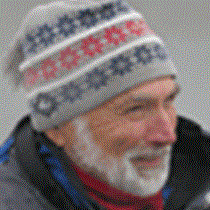Isla San Marcos and Santa Rosalia
The morning started with a beautiful sunrise and bow-riding bottlenose dolphins. It was such a treat to peer over the bow and watch these exquisitely designed creatures delicately play with our pressure wave to produce a free ride. There was a young animal with its mom, four others, and a very large scared male.
We were soon hiking up a broad wash on Isla San Marcos. One of a pair of ospreys occupied a nest that was atop a ragged pinnacle. They seemed tolerant as we hiked up a palo blanco stuffed arroyo. The white bark and dark green leaves transformed these little canyons into places that beckoned us. Some hikers reached a ridge for views of the ship and surrounding land, while others followed a sandy path through the trees. Those on shorter hikes had time to search tide pools for hidden treasures. Sea urchins and anemones were the more obvious denizens but on the edges were intriguing and cryptically colored nudibranchs like the one pictured above. Nudibranch means naked gill. This gastropod is a specialized snail that has lost its shell. Here we probably have the genus Dendronotus, which is a group of accomplished swimmers when provoked. This one seemed quite at home nestled on the fingers of a delighted lady naturalist. Their seaweed-like tufts are so numerous that it takes a skilled observer to be able to find them amongst the pieces of marine algae on the side of a tidepool.
In the afternoon we tied to the dock at Santa Rosalia and were off to explore this old mining town. Copper was first extracted here in the late 1880's by a French company called Compagnie Boleo. The French influence can still be seen in many of the houses and company buildings that were built using French Colonial architecture. Later we visited a mining museum and then lived a bit of history. We sat around on the veranda and inside the Hotel Frances drinking beer, sipping margaritas, and gazing out onto the Sea of Cortez. The hotel had many turn-of-the-century photos of the area hanging on its walls. One could look down onto the harbor and imagine the square-rigged ships being filled with copper ore that would sail to the Pacific Northwest for processing and return with lumber to build the town. We soon left this time capsule and were back in the comfort of our ship.
The morning started with a beautiful sunrise and bow-riding bottlenose dolphins. It was such a treat to peer over the bow and watch these exquisitely designed creatures delicately play with our pressure wave to produce a free ride. There was a young animal with its mom, four others, and a very large scared male.
We were soon hiking up a broad wash on Isla San Marcos. One of a pair of ospreys occupied a nest that was atop a ragged pinnacle. They seemed tolerant as we hiked up a palo blanco stuffed arroyo. The white bark and dark green leaves transformed these little canyons into places that beckoned us. Some hikers reached a ridge for views of the ship and surrounding land, while others followed a sandy path through the trees. Those on shorter hikes had time to search tide pools for hidden treasures. Sea urchins and anemones were the more obvious denizens but on the edges were intriguing and cryptically colored nudibranchs like the one pictured above. Nudibranch means naked gill. This gastropod is a specialized snail that has lost its shell. Here we probably have the genus Dendronotus, which is a group of accomplished swimmers when provoked. This one seemed quite at home nestled on the fingers of a delighted lady naturalist. Their seaweed-like tufts are so numerous that it takes a skilled observer to be able to find them amongst the pieces of marine algae on the side of a tidepool.
In the afternoon we tied to the dock at Santa Rosalia and were off to explore this old mining town. Copper was first extracted here in the late 1880's by a French company called Compagnie Boleo. The French influence can still be seen in many of the houses and company buildings that were built using French Colonial architecture. Later we visited a mining museum and then lived a bit of history. We sat around on the veranda and inside the Hotel Frances drinking beer, sipping margaritas, and gazing out onto the Sea of Cortez. The hotel had many turn-of-the-century photos of the area hanging on its walls. One could look down onto the harbor and imagine the square-rigged ships being filled with copper ore that would sail to the Pacific Northwest for processing and return with lumber to build the town. We soon left this time capsule and were back in the comfort of our ship.



